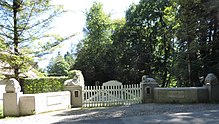Mathias Gasteiger
Mathias Gasteiger also: Matthias Gasteiger (born June 24, 1871 in Munich ; † July 7, 1934 there ) was a German sculptor , draftsman and entrepreneur.
Life and artistic work
His ancestors were farmers in the Puster Valley . Mathias Gasteiger graduated from the art academy in his hometown and was apprenticed to Victor Tilgner in Vienna, who was just creating the Mozart monument in the Burggarten from Lasa marble . After studying at the Royal Academy of Fine Arts with Syrius Eberle , Mathias Gasteiger set up a studio in Schwabing . In addition to his artistic activity, he taught in the summer (together with Julius Exter ) in his own painting and sculpture school in Deutenhofen Castle near Dachau , where he had lively contact with local artists such as B. Adolf Hölzel and Ludwig Dill used to. In his painting and sculpture school he met his future wife, Anna Karolina Sophie Meyer, who was born in Lübeck in 1877. Anna Karolina Sophie Gasteiger made a name for herself especially as a flower painter.
In 1902 the Gasteigers moved to Holzhausen am Ammersee , where the artists' association Die Scholle grouped around them. so z. B. Fritz Erler , Walter Georgi , Adolf Münzer , Leo Putz and Eduard Thöny . Mathias and Anna Karolina Sophie Gasteiger were the first to build a house on the west bank of the Ammersee with a line of sight to the Andechs monastery; Holzhausen as an artist colony is thus their discovery. In the Künstlerhaus, which is surrounded by a landscape park and open to the public, there is now a museum. The ensemble that was created over ten years with the farm buildings scattered around the site is unique for Munich Art Nouveau . The Bauernstube in the Künstlerhaus is a popular place for civil weddings.
Simultaneously with the settlement in Holzhausen, the artist couple moved their Munich (main) residence to the Munich district of Gern . There they were the social center of the celebrities of Gern and created connections between the artist colonies Dachau, Gern and Holzhausen.
The artist was the owner of quarries in Franconia and Laas . He was instrumental in the development of systems for the extraction and transport of Lasa marble.
Mathias Gasteiger created several sculptures for Munich. His fountain group Satyr herme with boy , popularly known as Brunnenbuberl , caused a tangible scandal around the unstylized naked boy at the time . Prince Regent Luitpold had personally asked the artist for a fig leaf for the uncovered boy, but the request was unheard of.
The grave of Mathias Gasteiger and his wife Anna Sofie Gasteiger is in the cemetery of the St. Ulrich church in Holzhausen
Award
1893: Gold medal at the Great Art Exhibition in Berlin
Works (selection)
- Satyr bath with boy
- Diana fountain
- Equestrian statue on the racetrack in Munich-Riem
- Bavarian soldier in bronze (1914), size 48.5 cm
- Horse tamer
- Garden gate Holzhausen Ammersee
literature
- Elmar, D. Schmid, Sabine Heym: Mathias and Anna Gasteiger , Dachau 1985
Web links
Individual evidence
- ^ Academy of Fine Arts Munich: Mathias Gasteiger, 00557, third matriculation book 1884-1920 . Retrieved October 3, 2011.
- ↑ http://www.schloesser.bayern.de/deutsch/service/infomat/screen-pdf/gasteiger_dt.pdf
- ↑ Municipality of Utting am Ammersee - current. Retrieved December 12, 2019 .
- ^ Munich and its fountains. Retrieved December 12, 2019 .
- ↑ http://www.monacomedia.de/muenchenwiki/index.php/Brunnenbuberl
- ↑ http://www.monacomedia.de/muenchenwiki/index.php/Dianabrunnen
- ^ Mathias Gasteiger. Retrieved December 12, 2019 .
| personal data | |
|---|---|
| SURNAME | Gasteiger, Mathias |
| ALTERNATIVE NAMES | Gasteiger, Matthias |
| BRIEF DESCRIPTION | German sculptor and draftsman |
| DATE OF BIRTH | June 24, 1871 |
| PLACE OF BIRTH | Munich |
| DATE OF DEATH | July 7, 1934 |
| Place of death | Munich |



